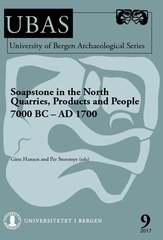| dc.contributor.author | Hansen, Gitte | |
| dc.contributor.author | Jansen, Øystein J. | |
| dc.contributor.author | Heldal, Tom | |
| dc.contributor.editor | Hansen, Gitte | |
| dc.contributor.editor | Storemyr, Per | |
| dc.date.accessioned | 2017-09-07T08:17:05Z | |
| dc.date.available | 2017-09-07T08:17:05Z | |
| dc.date.issued | 2017-08 | |
| dc.identifier.isbn | 978-82-90273-90-8 | |
| dc.identifier.issn | 0809-6058 | |
| dc.identifier.uri | https://hdl.handle.net/1956/16587 | |
| dc.description.abstract | In this study geological and archaeological data and analytic methods are combined and explored to find the geological source for 146 late Iron Age/Viking Age and early medieval soapstone vessels from the Hordaland region and the town of Bergen in western Norway. The dataset comprises archaeological and geological data relating to the vessels and to 38 soapstone quarries in the Hordaland region. The geological datasets are major and trace element and rare earth element data, as well as the geological setting of the Hordaland region. The archaeological datasets comprise information on the temporal and spatial contexts of the vessels and the quarries. The geochemical datasets are studied and categories established of geochemically based matches made between vessels and quarries. The reliability of these categories of match is then critically assessed through the application of other datasets. Subsequently, the match between individual vessels and regional quarries is given a provenance point-score that reflects the reliability of the provenance result. Through the interdisciplinary efforts provenancing results are obtained for 131 vessels. The success rate is thus high. The immediate social and historical implications of the provenancing results are briefly elaborated upon: previously undated quarries are now tentatively dated through vessel match; distinct quarry-districts that were in use during the late Iron Age/Viking Age and the early Medieval period have been discerned, and the contours of the organisation of the regional production of and trade in soapstone vessels during the Viking Age and the early Middle Ages are recognised. Finally, it is shown that late Iron Age/Viking Age rural households received vessels from areas from outside the Hordaland region to a much lesser degree than their early medieval urban counterparts. | eng |
| dc.description.sponsorship | Norges forskningsråd 210449 Universitetsmuseet i Bergen Tromsø museum - Universitetsmuseet NTNU Vitenskapsmuseet | eng |
| dc.language.iso | eng | eng |
| dc.publisher | University of Bergen | eng |
| dc.relation.ispartofseries | UBAS - University of Bergen Archaeological Series | eng |
| dc.rights | Attribution CC BY-NC-SA | eng |
| dc.rights.uri | http://creativecommons.org/licenses/by-nc-sa/4.0/ | eng |
| dc.title | Soapstone Vessels from Town and Country in Viking Age and Early Medieval Western Norway. A Study of Provenance | eng |
| dc.type | Chapter | eng |
| dc.type | Peer reviewed | eng |
| dc.description.version | publishedVersion | |
| dc.rights.holder | Copyright the authors | eng |
| dc.source.40 | 9 | |
| dc.source.pagenumber | 249-328 | |
| dc.subject.nsi | VDP::Humaniora: 000 | |
| dc.subject.nsi | VDP::Matematikk og Naturvitenskap: 400 | |

